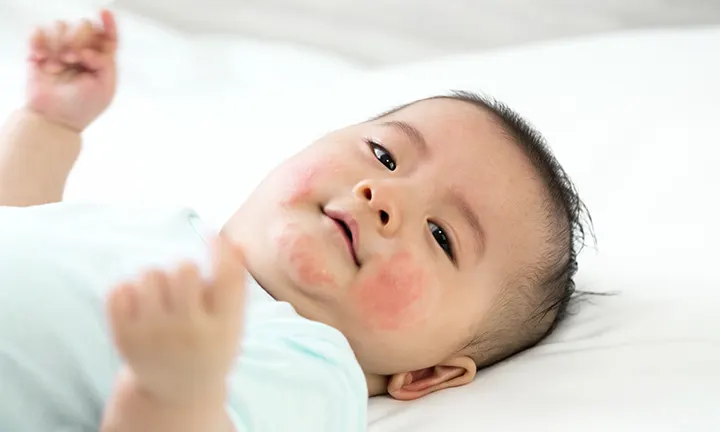Every parent hopes for a smooth experience as their little one starts exploring new tastes and textures. Food can sometimes bring unexpected surprises for your baby.
Recognizing signs pointing to a possible food allergy or intolerance is important for keeping your child happy and healthy.
Symptoms can present in various ways—think rashes, tummy troubles, or even unexpected behavioral shifts.
For example, if you notice your baby developing eczema not long after trying something new, it could be a signal worth looking into. Staying alert and informed helps you figure out if your baby is having reactions to certain foods and needs a little extra care.
Recognizing Symptoms Of Food Allergy
| Symptom Category | Common Symptoms | Timeframe After Eating | What to Do |
|---|---|---|---|
| Skin Reactions | Hives, redness, eczema flare-ups, swelling (face, lips, eyes) | Within minutes to 2 hours | Stop feeding, monitor closely, consult a pediatrician |
| Digestive Issues | Vomiting, diarrhea, stomach pain, excessive gas | 1 to 4 hours | Keep baby hydrated, contact a doctor if symptoms persist |
| Respiratory Symptoms | Wheezing, nasal congestion, shortness of breath, coughing | Within minutes to 1 hour | Seek immediate medical help if breathing is affected |
| Oral Symptoms | Itchy mouth, swollen tongue, difficulty swallowing | Immediately to 30 minutes | Stop feeding, watch for worsening signs, call a doctor |
| Severe Reaction (Anaphylaxis) | Difficulty breathing, swelling of throat, weak pulse, blue lips, loss of consciousness | Within minutes to 1 hour | Call emergency services (911) immediately, use epinephrine if available |
| Delayed Reactions | Eczema flare-ups, chronic diarrhea, slow weight gain | Hours to days | Consult an allergist for testing and diagnosis |
It’s not always easy to identify what’s going on when your child isn’t feeling well. Observing signs like skin reactions, especially hives, can give you a clue that something might be off.
You may also notice gastrointestinal distress, such as vomiting or diarrhea, popping up after certain meals.
Keep an eye out for any respiratory issues too; things like wheezing or a runny nose can signal a problem.
And let’s not forget behavioral changes—if your little one seems fussy or unusually tired, it might point to a food allergy. Staying aware of these indicators can help you catch potential issues early on.
Understanding Food Intolerance Differences
When it comes to food-related issues, it’s easy to confuse various conditions. While food allergies can provoke serious immune responses, food intolerances operate differently.
They often lead to unpleasant symptoms, such as bloating or digestive distress, after exposure to certain allergens.
Some individuals may even experience skin rashes or respiratory issues, which highlights the importance of paying close attention to what’s on your plate.
If you think you might have an intolerance, trying an elimination diet is a smart move. This process involves cutting out suspect foods and then slowly reintroducing them to identify what’s causing the discomfort.
Food Intolerances
- Food intolerances can lead to symptoms such as bloating, gas, and digestive distress.
- Unlike food allergies, food intolerances do not trigger an immune response but can still cause significant discomfort.
- Elimination diets are an effective method for identifying food intolerances by removing suspect foods from the diet.
- Reintroducing foods slowly after an elimination period helps pinpoint specific triggers for symptoms.
Common Infant Reactions To Allergens
For any parent, it’s quite the surprise when a tiny tummy reacts to something they’ve devoured. Early detection of these responses can make a world of difference.
You might spot signs like hives or rashes popping up shortly after introducing a new food.
Plus, watch out for any gastrointestinal issues, such as vomiting or diarrhea, which could indicate a food sensitivity.
It’s interesting how infants can express discomfort in different ways. If your little one seems fussier than usual or is particularly clingy following mealtime, it might be time to seek a pediatric consultation.
Recognizing these reactions is key to shielding your baby from potential issues, like a cow’s milk allergy or gluten sensitivity.
Shifting gears, let’s chat about what causes eczema in babies, as understanding these connections can help you navigate pediatric consultation, immunoglobulin E levels, food sensitivity, cow’s milk allergy, and gluten sensitivity.
What Causes Eczema In Babies
Taking care of your little one’s skin can feel like a bit of a puzzle. Genetics is one piece of the puzzle; if there’s a history of allergies or skin conditions in the family, your baby might be more prone to issues.
Environmental elements also influence this delicate situation.
Think about dust mites, pet dander, and even pollen—all of these can irritate soft skin and lead to uncomfortable flare-ups.
Food sensitivities can add another layer to this mix; for instance, babies with a soy allergy might experience a reaction that exacerbates skin irritation. Keeping a close eye on mealtime reactions is important, especially if your baby shows signs after trying something new.
Catching these triggers early can really help in soothing those irritations.
Baby Skin Care
- Genetic predisposition can increase the likelihood of skin allergies or conditions in infants.
- Environmental allergens like dust mites and pet dander can trigger skin irritations in babies.
- Food allergies, such as soy, can lead to skin reactions that worsen irritation.
- Monitoring your baby’s reactions to new foods is essential for identifying potential triggers.
Identifying Gastrointestinal Distress Signs
Babies can sometimes feel like little enigmas, especially when their tummies are involved. It’s important to get a feel for their usual eating habits and bowel patterns.
Most infants will have predictable feeding and bowel routines.
If you notice excessive crying, it could signal cramping or discomfort lurking beneath the surface.
Red flags to keep an eye out for include unusual bowel movements, ongoing irritability, or fussiness after feeding. These signs can help you spot when something might be off with your baby’s gastrointestinal health.
Next up, let’s talk about how food can play a role in your baby’s comfort.
Babies often show that they’re not feeling well in a variety of ways, and you might see increased fussiness during feedings. Physical symptoms can also include cramping, bloating, irritability, crying, and feeding difficulties.
Monitoring Skin Rashes And Hives
Seeing your skin react can throw you for a loop, but tuning into those changes is absolutely key. Often, they hint at allergic reactions or even digestive issues that might be brewing beneath the surface.
Keep an eye out for symptoms like itching or redness, which can signal a histamine response.
Tracking when these rashes pop up is super helpful for pinpointing allergy triggers, allowing you to steer clear of them in the future. Your skin is like a little messenger, sharing important information about what’s going on inside, so make sure to pay attention to potential digestive issues, allergic reactions, histamine responses, allergy triggers, and crossreactivity!.
Skin Reactions
- Skin reactions can indicate underlying health issues, such as allergies or digestive problems.
- Common symptoms of allergic reactions include itching, redness, and swelling.
- Tracking the timing and triggers of skin rashes can help identify specific allergens.
- Histamine responses in the skin are often linked to food allergies and sensitivities.
Consulting With A Pediatric Allergist
Taking the step to see a specialist for your child’s health is a journey toward better understanding their needs. Meeting with a professional can offer deep insights into the world of pediatric allergies, especially if there’s a family history of sensitivities.
During your visit, the allergist will conduct an assessment of your child, asking questions about their symptoms and potentially providing a clinical diagnosis.
It’s common to undergo several tests, which can shed light on any pediatric allergies they may be facing.
By the end of the appointment, you’ll be equipped with various treatment options tailored to your child’s needs, along with actionable steps for monitoring health effectively. Remember, this process is all about helping your little one thrive.
Dietary Modifications For Allergic Babies
Adjusting what your little one eats can bring up a mix of feelings for any parent, especially when allergies are involved. When you’re out shopping, knowing how to read food labels makes a big difference.
Start by pinpointing the common allergens like milk, eggs, and nuts that might be hiding in your groceries.
When you’re ready to introduce new items into their meals, go for one at a time so you can easily spot any reactions.
If you have concerns, an allergist referral might be the next step; they can suggest tests like a skin prick test or blood tests to get a clearer picture. Keeping meals interesting while avoiding allergens is easier than it sounds—swapping ingredients can help you create delicious and safe dishes.
This way, you’re ensuring your baby receives the nourishment they need without any risks involved.
Managing Food Allergies in Children
- Approximately 5-8% of children in the U. S. have food allergies, making it essential for parents to be vigilant about food labels.
- Common allergens include milk, eggs, peanuts, tree nuts, soy, wheat, fish, and shellfish, which can often be hidden in processed foods.
- Introducing new foods one at a time can help identify potential allergic reactions, as recommended by pediatricians.
- Allergists may conduct skin prick tests or blood tests to accurately diagnose food allergies and provide tailored dietary advice.
Conclusion
Looking back on our previous discussions, it’s apparent how important it is to monitor your baby’s food experiences. Recognizing early signs can facilitate preventive strategies that effectively manage potential allergies.
Collaborating with your healthcare provider is key for a thorough nutritional assessment tailored to your little one.
Keeping a detailed record of what your baby eats and their reactions can prove invaluable when assessing dietary modifications.
If you have any concerns about allergies or intolerances, don’t hesitate to reach out to your pediatrician. Your intuition and involvement make a significant difference in this journey; prioritizing your child’s well-being and being their best advocate is what it’s all about, especially when incorporating preventive strategies, dietary modifications, nutritional assessment, probiotic usage, and formula analysis into their care.
Originally posted 2025-03-21 12:30:21.




